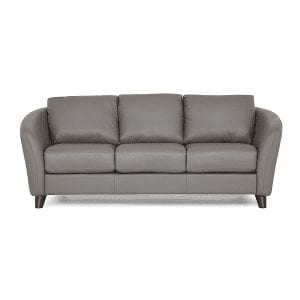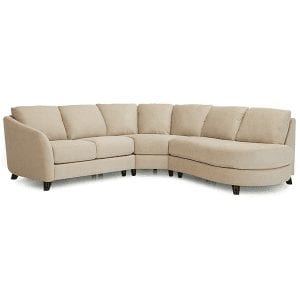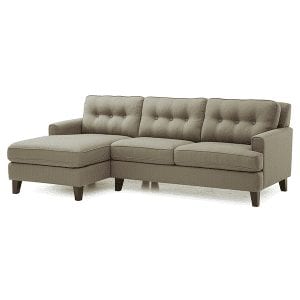Arranging bedroom furniture is a lot like art. It’s all about expressing yourself and creating something that fits your mood and taste.
Think of a bedroom like a blank canvas. There’s a finite amount of space for your creativity and inspiration. The possibilities are endless—within the confines of four sides and four corners, of course.
Even the most free-spirited artists lean on technical knowledge and best practices to guide them. They understand how colors pair and mix. How to use negative space. How lighting can accentuate their artwork. Why not take a similar approach to your bedroom layout? Start with the fundamentals and then let your creative instincts handle the rest.
On the upside, you’re the alpha and the omega. You decide how to arrange a bedroom, and the only person you have to make happy is you. That said, here are our bedroom furniture placement tips to help you make your space a masterpiece.
1. Pick pieces that are proportional.
Does your bedroom’s balance seem out of whack no matter how you rearrange the furniture? If so, you probably have furniture that’s either too big or too small for the room. Bedroom furniture pieces should be proportional to the room’s dimensions, ceiling height and windows. If they’re not, it might be time to replace them.
Measure your bedroom before you go furniture shopping. The average bedroom size in an American home is about 200 square feet—only big enough to accommodate a queen bed. If you’re browsing bedroom furniture sets, look for one with pieces that won’t overwhelm the space. If your bedroom is larger, you’ll need larger furniture. It’s all about scaling.
2. Figure out where the bed belongs.
Where to put the bed in your bedroom isn’t always obvious. Based on doors, windows and electrical outlets, there might only be one suitable spot for your comforter-clad sleep chariot. If you have a larger bedroom, though, there might be too many options. Now you’re gripped by paralyzing indecision.
Bed placement can be tricky. There’s no right spot per se, but a bed in the wrong spot will throw off the room’s aesthetics, logistics or both. First, decide whether you want your bed visible from the door. Then, pick a spot that makes sense and saves the most space—usually against a wall. If you’re still struggling, these feng shui bedroom rules may help.
3. Go with the flow when arranging bedroom furniture.
While we most often associate bedrooms with sleeping, these rooms—especially larger ones and master bedrooms—handle a certain amount of foot traffic. There are well-worn paths to the dresser, master bath or reading nook. Good bedroom layouts foster this flow rather than restrict it.
Sometimes it helps to sketch out your floor plan in a way that preserves those pedestrian lanes. Again, size matters when it comes to your bedroom furniture layout. Dressers, nightstands and armoires should be right-sized and situated in spots that don’t impede movement. Most importantly, leave plenty of space to navigate the bed.
4. Symmetry is swell but not imperative.
Interior designers have long used symmetry as a go-to technique for a tidy look, especially in smaller spaces. But bedrooms are as different as the people who spend hours and hours in them. Their shapes can range from boxy to narrow to curved. Windows, doors and shelving pose even more complications if you’re looking for that symmetrical sensibility.
Embrace the uniqueness of the space when arranging bedroom furniture. If the room has an odd shape, go with it. Not all bedrooms can be in absolute balance with a perfectly centered bed flanked by nightstands.
5. Oblige—don’t obstruct—windows.
Windows can be a bedroom’s best attribute and also its biggest challenge for furniture placement. A bedroom bathed in natural light is hard to resist during the daytime hours (just ask your cat). That’s why it’s best to accommodate these glass portals when arranging bedroom furniture.
Pay special attention to where your bed is relative to bedroom windows. Unless you like a wake-up call in the form of bright sunlight, don’t position your bed opposite east-facing windows. Try placing lower beds and dressers in front of windows and framing them with curtains that complement your bedding. If that’s not an option, one of these bedroom layout ideas might work for your windows.
6. Small bedrooms can still be stylish.
In reality, many bedrooms are limited on space. Your bedroom furniture challenges are more likely related to what will fit in a compact space versus finding more pieces to make it feel less cavernous. The good news is that small bedrooms can be brilliantly arranged with the right furniture.
Small bedroom layout is all about creatively using your available space. That usually means fewer furniture pieces that are less bulky, more vertical and storage-friendly. It’s no surprise that minimalism melds well with small bedrooms. Just remember, you’re aiming for simple, not spartan.
7. Squeeze in some seating, if possible.
More spacious bedrooms often have an ideal spot for seating. Some may only have enough room for a single chair or bench, while others can accommodate a love seat or small sofa. Whether your bedroom has an ancillary alcove or deep den, you’ll want to fill the emptiness with some comfortable furniture.
Bedroom seating not only completes your look, it’s just plain functional. Everyone needs a place to lace up their sneaks or lay out tomorrow’s outfit. Larger bedrooms also bring more opportunities to flex your interior design muscle. Try mixing and matching pieces for a unique flair you can call your own.
If you need professional advice on how to arrange a bedroom or which furniture pieces work best for your space, contact us today or stop by our showroom. We’d love to help!



